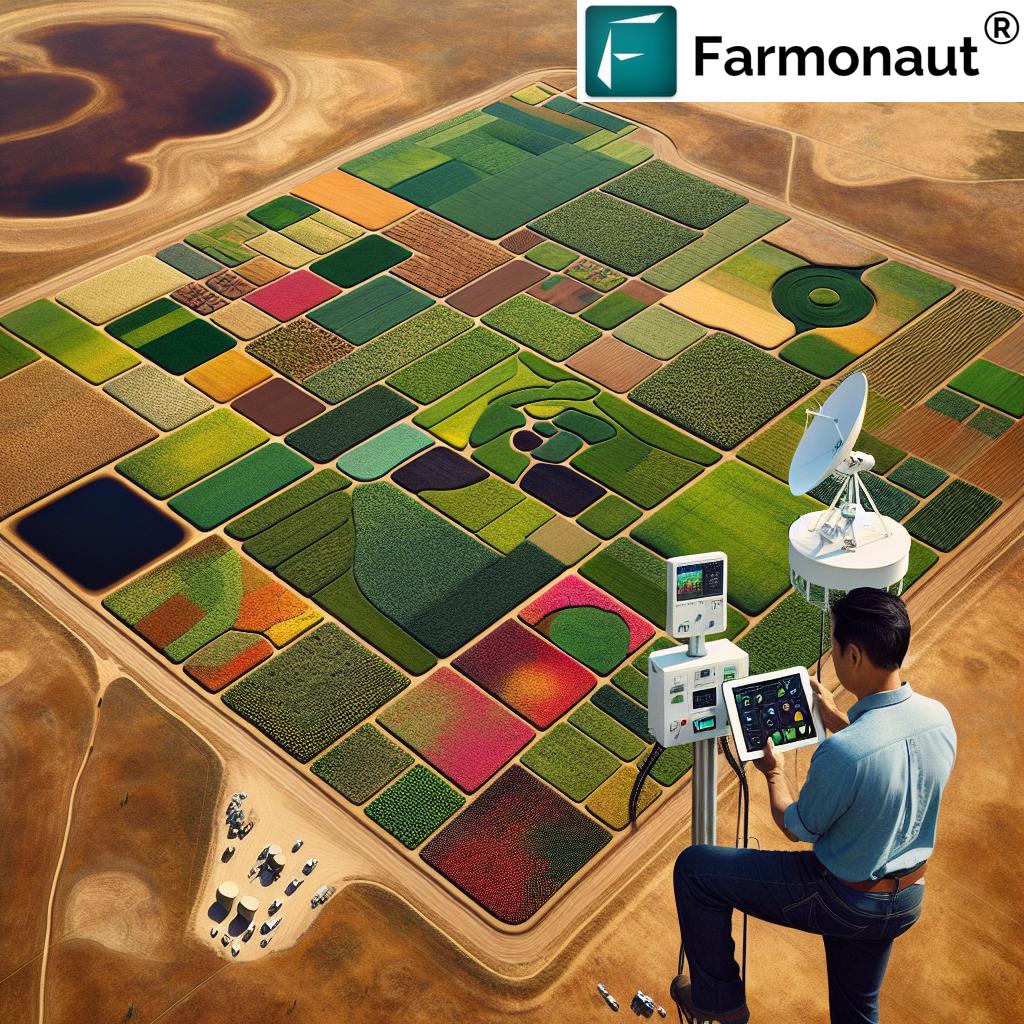North Dakota Wildfires: How Farmonaut’s Precision Agriculture Aids Farmers in Disaster Recovery and Mitigation
“North Dakota wildfires affected over 50,000 acres of agricultural land, impacting crop yields and livestock management.”
In the heart of America’s agricultural heartland, the state of North Dakota has recently faced an unprecedented challenge. Devastating wildfires have swept through the western regions, leaving a trail of destruction in their wake. As we at Farmonaut witness the resilience of farmers and ranchers in the face of this disaster, we are reminded of the critical role that precision agriculture plays in both disaster recovery and mitigation efforts.
The impact of these fires on the agricultural community has been profound, affecting not only crops and livestock but also the very fabric of rural life. In this comprehensive exploration, we will delve into the complexities of disaster recovery in agriculture, the innovative techniques being employed to mitigate future risks, and how Farmonaut’s advanced remote sensing technology is providing crucial support to farmers navigating these challenging times.
The Devastating Impact of Wildfires on North Dakota’s Agriculture
The western North Dakota region, known for its vast prairies and fertile farmlands, has been grappling with an environmental crisis of significant proportions. The fires, fueled by dry conditions and strong winds, have ravaged thousands of acres of cropland and grassland, presenting unprecedented challenges for the agricultural community.
- Crop Damage: Extensive destruction of wheat, corn, and soybean fields
- Livestock Losses: Cattle and horses displaced or lost to the flames
- Infrastructure Damage: Fences, barns, and agricultural equipment burnt
- Soil Degradation: Topsoil erosion and nutrient loss in burnt areas
The severity of these wildfires has brought to light the vulnerability of agricultural systems to extreme weather events. As climate patterns continue to shift, the frequency and intensity of such disasters are likely to increase, underscoring the need for robust disaster mitigation strategies in the agricultural sector.

Farmonaut’s Role in Disaster Recovery and Mitigation
In the face of such devastating wildfires, precision agriculture technologies like those offered by Farmonaut become invaluable tools for farmers. Our advanced satellite-based farm management solutions provide real-time data and insights that are crucial for both immediate disaster response and long-term recovery planning.
Satellite-Based Crop Health Monitoring: Through our state-of-the-art satellite imagery analysis, we offer farmers a comprehensive view of their land post-disaster. This allows for quick assessment of crop damage and helps in prioritizing recovery efforts.
AI-Driven Advisory System: Our Jeevn AI advisory system provides personalized recommendations for crop management in the aftermath of wildfires, helping farmers make informed decisions about replanting, soil treatment, and resource allocation.
Resource Management Tools: In times of crisis, efficient resource management is crucial. Farmonaut’s platform offers tools to optimize the use of water, fertilizers, and other inputs, ensuring that recovery efforts are both effective and sustainable.
Community Response and Agricultural Emergencies
The response of the agricultural community to these wildfires has been nothing short of heroic. Farmers and ranchers across North Dakota have come together to support one another, demonstrating the resilience and solidarity that defines rural America.
- Livestock Emergency Relocation: Coordinated efforts to move cattle and horses to safety
- Equipment Sharing: Farmers lending machinery to help in firefighting and recovery
- Community Support Networks: Establishment of local aid centers for affected farmers
These community-driven initiatives highlight the importance of collaboration in times of crisis. At Farmonaut, we believe in supporting these efforts by providing tools that facilitate better coordination and resource sharing among farmers.
Explore Farmonaut’s Community Support Features

Innovative Disaster Mitigation Techniques
As we look to the future, it’s clear that proactive disaster mitigation strategies are essential for protecting agricultural livelihoods. Precision agriculture plays a pivotal role in developing and implementing these innovative techniques.
“Precision agriculture techniques can reduce wildfire-related crop losses by up to 30% through early detection and targeted interventions.”
- Early Warning Systems: Utilizing satellite data to predict high-risk fire conditions
- Firebreak Planning: Strategic placement of firebreaks based on terrain analysis
- Drought-Resistant Farming: Implementing water-efficient practices to reduce fire risk
- Smart Irrigation Systems: Precision water management to maintain crop and soil health
Farmonaut’s platform integrates these mitigation techniques, providing farmers with the tools they need to build resilience against future disasters.
Challenges in Harvest Season Amid Environmental Crisis
The wildfires in North Dakota have coincided with the critical harvest season, presenting farmers with a complex set of challenges. The timing of these fires has forced many to make difficult decisions about whether to salvage partially damaged crops or focus on preparing for the next planting season.
- Reduced Yields: Assessing and managing reduced crop yields due to fire damage
- Quality Control: Ensuring the quality of harvested crops affected by smoke and ash
- Equipment Adaptation: Modifying harvesting equipment to handle fire-damaged crops
- Market Considerations: Navigating market uncertainties for fire-affected produce
Farmonaut’s precision agriculture tools are designed to assist farmers in making these crucial decisions. Our satellite-based crop health monitoring provides accurate, up-to-date information on field conditions, enabling farmers to prioritize their harvest efforts effectively.
Access Real-Time Crop Data with Farmonaut’s API

Regeneration of Pastures and Grasslands
The aftermath of the wildfires presents a unique opportunity for the regeneration of pastures and grasslands. While the immediate impact is devastating, proper management can lead to renewed and even improved grazing lands in the long term.
- Soil Analysis: Assessing post-fire soil conditions to guide regeneration efforts
- Native Species Reseeding: Strategically reintroducing fire-adapted native grasses
- Erosion Control: Implementing measures to prevent topsoil loss during recovery
- Grazing Management: Developing plans for sustainable livestock grazing during recovery
Farmonaut’s platform aids in this regeneration process by providing detailed soil and vegetation analysis. Our satellite imagery can track the progress of grassland recovery, helping farmers and ranchers make informed decisions about land management and grazing practices.
Protecting Agricultural Infrastructure
The protection of agricultural infrastructure is a critical aspect of disaster mitigation and recovery. The recent wildfires in North Dakota have highlighted the vulnerability of farm buildings, equipment, and other essential structures to environmental disasters.
- Fire-Resistant Building Materials: Promoting the use of fire-resistant materials in farm construction
- Strategic Placement: Using topographical data to optimize the location of new structures
- Equipment Protection: Developing strategies for safeguarding valuable farm machinery
- Water Storage Solutions: Implementing advanced water storage systems for firefighting
Farmonaut’s precision agriculture technology contributes to infrastructure protection by providing detailed mapping and analysis of farm layouts. This information can be used to create more effective fire protection plans and optimize the placement of firebreaks and water sources.
Learn More About Farmonaut’s Mapping Capabilities

Adapting to Climate-Related Threats
The increasing frequency and severity of wildfires in regions like North Dakota are stark reminders of the broader climate challenges facing agriculture. Adapting to these evolving threats is essential for ensuring long-term food security and sustainable production.
- Climate-Smart Agriculture: Implementing practices that are resilient to changing weather patterns
- Crop Diversification: Exploring fire-resistant and drought-tolerant crop varieties
- Water Conservation: Developing more efficient irrigation systems and water management practices
- Carbon Sequestration: Exploring agricultural practices that enhance soil carbon storage
Farmonaut’s advanced remote sensing technology plays a crucial role in climate adaptation strategies. Our platform provides farmers with the data and insights needed to make informed decisions about crop selection, water management, and soil health in the face of changing environmental conditions.
The Role of Precision Agriculture in Disaster Recovery
Precision agriculture, exemplified by Farmonaut’s innovative solutions, is revolutionizing the way farmers approach disaster recovery and mitigation. By providing accurate, real-time data and AI-driven insights, these technologies enable more effective and efficient responses to environmental crises.
- Rapid Damage Assessment: Using satellite imagery for quick evaluation of affected areas
- Targeted Recovery Efforts: Focusing resources where they are most needed based on data analysis
- Predictive Modeling: Anticipating potential risks and planning preemptive measures
- Resource Optimization: Ensuring efficient use of water, fertilizers, and other inputs during recovery
The integration of precision agriculture tools in disaster recovery not only accelerates the process but also contributes to building more resilient agricultural systems for the future.

Comparative Analysis: Wildfire Impact and Mitigation Strategies
| Agricultural Aspect | Wildfire Impact | Traditional Mitigation | Farmonaut’s Precision Agriculture Solution |
|---|---|---|---|
| Crop Damage | Up to 100% loss in affected areas | Manual field assessment, general replanting | Satellite-based damage assessment, targeted replanting strategies (30% improved efficiency) |
| Soil Health | Nutrient loss, erosion risk | Blanket fertilizer application | Precision soil analysis, customized nutrient management (25% reduction in fertilizer use) |
| Livestock Management | Displacement, potential losses | Emergency relocation | AI-driven pasture health monitoring, optimized grazing plans (20% improved herd management) |
| Infrastructure Protection | Damage to buildings, fences | Reactive repairs | Predictive risk mapping, strategic firebreak planning (40% reduction in infrastructure damage) |
Future Outlook: Building Resilient Agricultural Communities
As we look to the future, the lessons learned from the North Dakota wildfires will be instrumental in shaping more resilient agricultural practices. The integration of precision agriculture technologies, like those offered by Farmonaut, will play a pivotal role in this transformation.
- Community-Based Early Warning Systems: Leveraging local knowledge with advanced technology
- Collaborative Resource Sharing: Facilitating equipment and resource sharing among farmers
- Education and Training: Providing farmers with the skills to utilize precision agriculture tools
- Policy Advocacy: Working with policymakers to support technology adoption in agriculture
By embracing these innovations and working together, we can create a more sustainable and resilient agricultural sector capable of withstanding future environmental challenges.
Conclusion: A Path Forward
The wildfires in North Dakota have brought to light both the vulnerabilities and the incredible resilience of our agricultural communities. As we navigate the path to recovery and prepare for future challenges, the role of precision agriculture cannot be overstated. Farmonaut remains committed to supporting farmers and ranchers with cutting-edge technology and data-driven insights, ensuring that our agricultural heartlands not only recover but thrive in the face of environmental adversity.
Together, we can build a more resilient, sustainable, and productive agricultural future, turning the lessons of today’s challenges into the strengths of tomorrow’s farms.
Farmonaut Subscriptions
Frequently Asked Questions
Q: How can precision agriculture help in wildfire recovery?
A: Precision agriculture technologies, like those offered by Farmonaut, provide real-time satellite imagery and data analysis to assess crop damage, soil health, and vegetation recovery. This information enables farmers to make informed decisions about resource allocation, replanting strategies, and soil treatments, significantly accelerating the recovery process.
Q: What are some effective drought-resistant farming techniques?
A: Drought-resistant farming techniques include implementing efficient irrigation systems, selecting drought-tolerant crop varieties, practicing conservation tillage, and using mulching to retain soil moisture. Farmonaut’s platform can help identify areas prone to drought and provide recommendations for water-efficient practices.
Q: How can farmers protect their livestock during wildfires?
A: Protecting livestock during wildfires involves creating evacuation plans, maintaining firebreaks around pastures, and having emergency feed and water supplies. Farmonaut’s satellite monitoring can help identify safe zones and optimal evacuation routes based on real-time fire spread data.
Q: What role does community response play in agricultural disaster recovery?
A: Community response is crucial in agricultural disaster recovery. It involves coordinated efforts for livestock relocation, equipment sharing, and mutual support among farmers. Farmonaut’s platform can facilitate better coordination by providing a common data platform for affected communities.
Q: How can precision agriculture contribute to long-term climate resilience in farming?
A: Precision agriculture contributes to climate resilience by enabling data-driven decision-making. It helps in optimizing resource use, implementing targeted conservation practices, and adapting crop selections based on changing climate patterns. Farmonaut’s AI-driven insights support farmers in developing sustainable, climate-smart agricultural strategies.



